When a loved one is feeling sick or ill, we will do just about anything we can to help. It’s one of our natural instincts.
From grabbing prescriptions to, more recently, assisting in quarantine comfort, we all enjoy doing our part to make our sick or injured family members more comfortable.
However, when it comes to Parkinson’s Disease, there is a lot to consider when taking care of a loved one at home.
Let’s take a look at what exactly Parkinson’s Disease is, best practices, and things to be aware of.
What is Parkinson’s Disease?
IN THIS ARTICLE
Before we get into any care tips, let’s break down exactly what Parkinson’s Disease is.
Parkinson’s Disease (PD) is a progressive neurodegenerative disorder. Unfortunately, this means that the individual’s symptoms and difficulties increase over time.
Likewise, the emphasis and level of care will have to increase as the disease progresses.
Those caring for Parkinson’s patients at home will have to adapt their environment as the disease progresses, but we will touch more on that below.
Anticipating the progression and symptoms of PD is critical for a home caretaker. This knowledge will allow you to plan your care and home and make the transition as seamless as it can be.
Important note: caring for a loved one with Parkinson’s Disease is hard, and there should be no guilt in admitting so.
You may feel it’s your responsibility single-handedly to care for them, but never be afraid or ashamed of asking for help. From friends, family, or even professional nurse staffing agencies – there are resources that can help provide some peace of mind.
With that said, let’s look at exactly what you can expect.
Parkinson’s Disease Symptoms: What to Expect
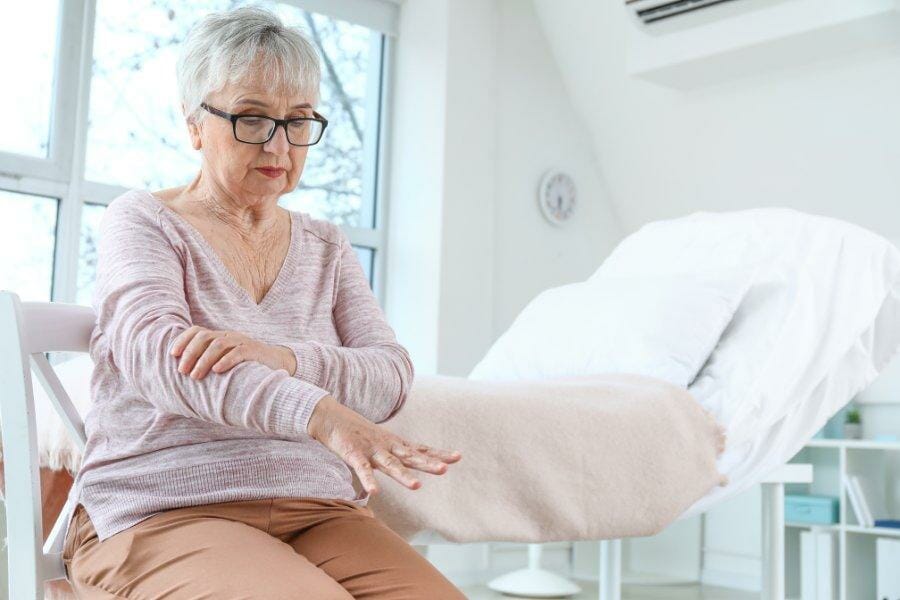
Now that we have a better understanding of what Parkinson’s Disease is, what behaviors and symptoms should you be on the lookout for?
Common symptoms of Parkinson’s Disease may include the following:
- Tremors and trembling
- Stiffness of limbs
- Stiffness in body
- Bradykinesia (overall slowness of movement)
- Impaired balance
- Forward-leaning gait
- Poor coordination
- Difficulty initiating or continuing movement
- Trouble speaking, chewing, and swallowing
- Difficulty sleeping
- Depression and emotional changes
- Delusions
- Dementia
Symptoms of early onset Parkinson’s often begin on one side of the body and will begin affecting the entire body once the disease progresses.
Important note: Parkinson’s Disease symptoms vary from person to person and are occasionally dismissed as just typical effects of aging. The subtle slower movement and impeded coordination are culprits of this dismissal.
It is important to be vigilant when assessing potential Parkinson’s symptoms and always refer to a healthcare expert’s opinion.
The Stages of Parkinson’s Disease Symptoms
Early Stages
Parkinson’s symptoms are typically mild in the early stages of the disease and have little to no impact on day-to-day activities.
This may cause a delay in diagnosis, and as PD progresses, the symptoms increasingly become disruptive.
Middle Stages
The middle stages of PD are when balance problems, tremors, and falling may increase.
Daily activities become more stressful for Parkinson’s patients, although up until this point these individuals likely have been able to lead an independent lifestyle.
Assistance may become necessary, as walking and concise movements become more difficult.
Advanced Stages
The advanced stages of PD likely include delusions and dementia, in addition to significant tremors and difficulty moving.
Most PD patients in the advanced stage cannot move independently and require full-time care, whether that be from family or a full-time nurse (or a combination thereof).
Home Care for Parkinson’s Patients
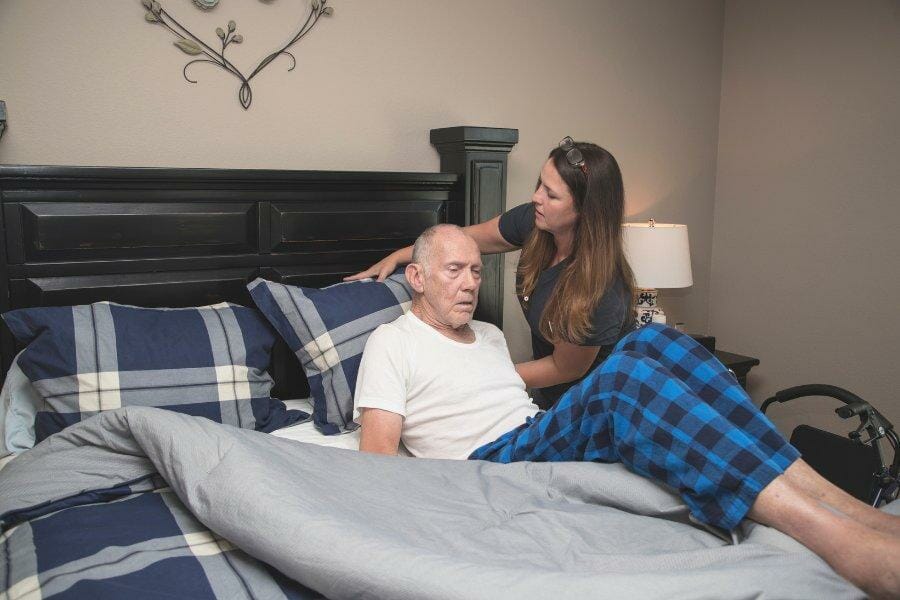
A great deal of home care for Parkinson’s patients is a balance between hands-on care with daily tasks along with an understanding of allowing the individual to patiently complete some activities on their own, depending on their stage of PD.
Simplifying daily activities, no matter how intricate, goes a long way for those suffering from Parkinson’s Disease.
The movement symptoms that accompany PD, such as tremors, overall weakness, and lack of balance, make these day-to-day activities cumbersome and even certain medications for Parkinson’s Disease can lead to side effects like lightheadedness, confusion, and drowsiness.
Mundane activities that we would otherwise not think twice about can be a massive challenge for PD patients, which may cause stress, frustration, or even humiliation.
Being able to provide care and peace of mind is essential.
Let’s take a look at some specific daily tasks and categories and how you can help care for a Parkinson’s patient at home.
Bathing, Grooming, and Personal Care
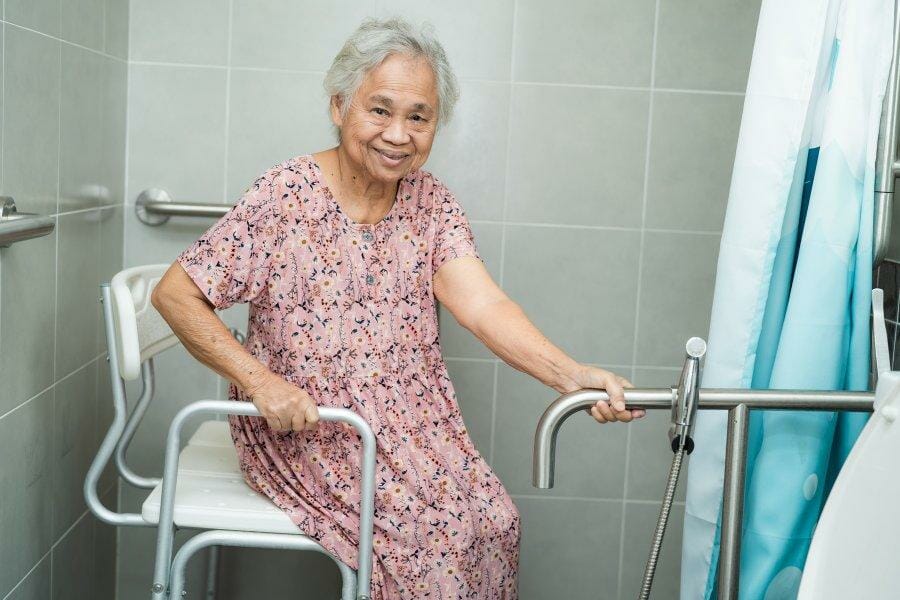
Try to use a shower if possible. Bathtubs always present a tripping and falling hazard. When bathing, have them sit on a comfortable shower stool and use a hand-held showerhead.
One tip is to wrap them in an absorbent Terry cloth robe after they are finished bathing. This can assist post-bathing without having to dry themselves off with a traditional towel.
Electric toothbrushes go a long way for those suffering from Parkinson’s Disease. It eliminates the need for additional hand movements. The same can be said with an electric razor.
If you are taking care of their dental hygiene needs, avoid touching the back of their tongue to prevent any form of gagging, and keep a small towel or washcloth nearby in case drooling is an issue.
Important note: As previously mentioned, dementia is associated with Parkinson’s Disease. In fact, it is reported by the Alzheimer’s Association that between 50% and 80% of PD patients experience symptoms of dementia.
Many individuals that suffer from dementia can be frightened or confused by the feel and sound of running water. Be gentle and give them time to adapt during bathing. Patience is key.
Getting Dressed with Parkinson’s Disease
The dressing process for someone with Parkinson’s can be a bit labor-intensive. The tremors and muscle stiffness can cause difficulty and make the activity unpleasant.
However, there are tips you can follow to alleviate some discomfort.
The planning process can make getting dressed with PD much easier. Lay out clothes ahead of time to avoid stress down the road.
Ask them if they have a preferred order of being dressed, and prepare the clothes in that fashion.
When possible, elect clothing that is simple to put on. This can include bras that hook in the front, loose-fitting shirts, pants with elastic waistbands, and tube socks.
If the Parkinson’s patient has a particular shirt or clothing item that they now have difficulty wearing, one tip is to replace buttons with velcro.
Avoid shoes with rubber soles as they become a tripping and falling risk.
Try to allow the PD patient to dress themselves whenever possible, but always be prepared and ready to assist.
Recommend that they sit down, take it slowly, and start with the side of their body that is more impacted by the disease.
Feeding a PD Patient
Fiber and calcium-rich foods are beneficial to those with Parkinson’s.
The fiber helps prevent constipation and calcium prevents osteoporosis, as falling and fractures are a major concern with PD patients.
Fiber sources can include:
- Fruits
- Vegetables
- Whole grains
- Bran cereals
- Specific fiber bars
Calcium sources can include:
- Cheese
- Vitamin D-fortified milk
- Greek yogurt
Some Parkinson’s patients have difficulty swallowing. If this is the case for your loved one, opt for soft, moist foods. Protein shakes and meal-replacement shakes are an option.
Avoid hard foods or food that easily crumbles.
Sleep Comfort and Tips
Sleek, satin bedsheets can help Parkinson’s Disease patients more seamlessly slide in and out of bed compared to thicker, flannel blankets.
Bedrails are useful to help maintain balance and always keep the pathway between the bed and the bathroom clear of rugs, objects, or any potential tripping hazard.
General Activities
Do your best to assist and encourage your loved one to continue participating in activities they love despite their progressing symptoms.
In the early stages, this tends to be emotional assistance.
When the symptoms progress to a point of intrusion, there are two common approaches you can take:
- Assistance
- Adaptation
Assistance pertains to you helping them with their activity. Whether it is helping them hold their paintbrush if they like painting or holding an arm while going for a stroll in the park.
There are also assistive technology and devices that exist for PD patients. This can include mobility aids, meal preparation, and communication aids.
The other approach is adaptation. For example, let’s say they love playing a musical instrument or shooting hoops.
At a certain point, the PD symptoms will become too disruptive for these activities. In that case, pivot to enjoying these activities in a different way.
Listen to music more frequently or attend more concerts and symphonies. Watch athletes play basketball at the local park or attend professional sporting events.
While these are not a perfect resolution to losing the ability to partake in these activities themselves, it is a way to redirect that passion and stay engaged.
Relaxing activities tend to benefit PD patients and help reduce stress, which is known to make symptoms more pronounced.
Aside from any daily movements or exercises their doctor may suggest, it can be helpful to exercise their jaw and face muscles by singing, reading out loud, or making silly faces.
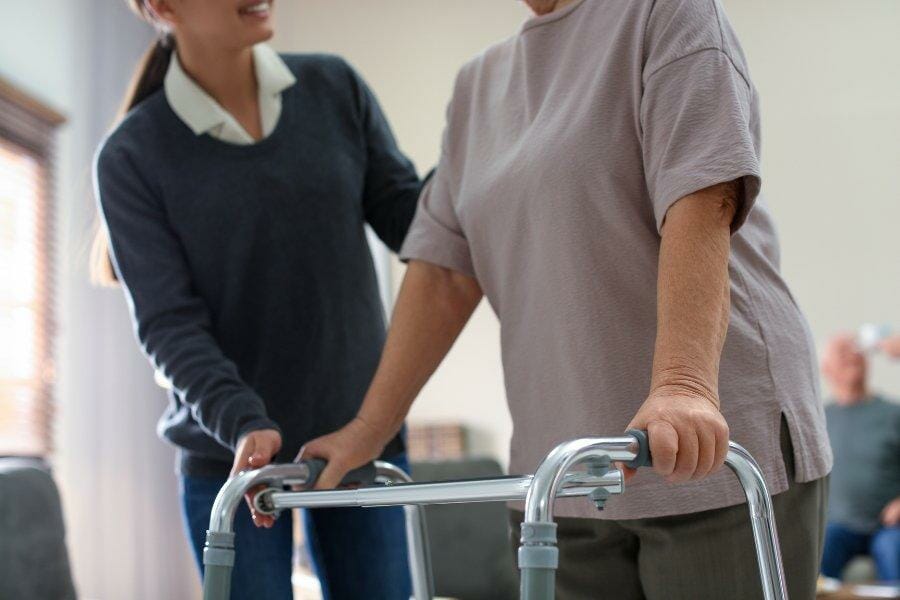
Emotional Care
The emotional care needed is a completely different component of caring for a loved one with Parkinson’s Disease.
It is clear that this disease majorly impacts one’s lifestyle – from hobbies and activities to bathing and eating. That is a hard pill to swallow upon diagnosis.
Your loved one will understandably require a lot of emotional support to come to terms with their diagnosis and cope with all of the lifestyle changes and adaptations this disease brings.
Expect a wide range of emotions between shock, denial, anger, sorrow, and frustration. Take some time to read the common emotions and stages of grief.
Do not let the diagnosis become a fear of the unknown. Educate yourself and your loved one on Parkinson’s disease, what to expect, and what type of actions you can take to make life easier and more enjoyable.
Learning about the condition will do nothing but help you prepare for the road ahead.
Encourage them to seek therapy or join a local or virtual support group to help them process their emotions and develop coping skills.
Your assistance and care are greatly needed, but speaking with others that are suffering from the same disease is a different type of value that you cannot provide.
Some aspects of caring for your loved one with PD will be frustrating and exhausting. Try your best to remember to be kind and patient. It goes a long way and they need your support.
Home Safety Considerations for Parkinson’s Disease
Parkinson’s disease frequently causes mobility issues, so improving the safety and usability of a patient’s home should be a top priority.
Wide, clear pathways in rooms and hallways are crucial because people with PD frequently use mobility aids like canes, walkers, rollators, or wheelchairs.
The following home elements can make it difficult for a person with limited mobility to get around their home safely.
Home Modifications for Loved Ones with PD
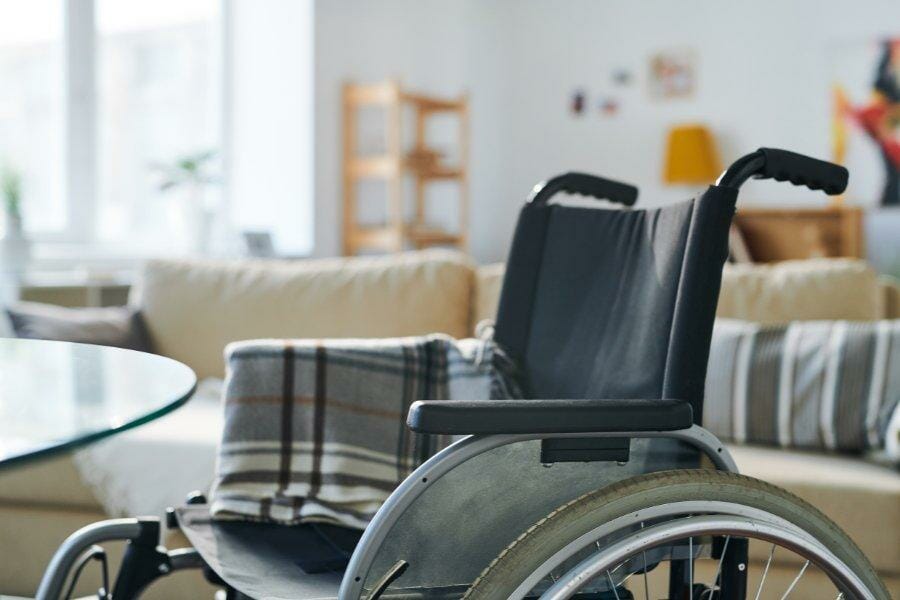
Furniture Arrangements
Furniture should be spaced apart enough to allow them to have easy access to every room in their home, along with any necessary mobility aids.
Placing furniture between 5.5 and 6 feet apart can help accommodate this.
Make sure any furniture that has wheels can be stabilized to prevent falling when the piece is being used to keep the individual steady.
Lighting
Adequate lighting in any home is important, but try to avoid floor lamps or table lamps that can be easily tipped over. This includes both placement and lighting fixture design qualities to consider.
Always tuck away electrical cords so they do not pose a tripping and falling hazard.
Floor Coverings
Walking on thick carpets can be riskier and more difficult than on thin carpets or bare floors. Parkinson’s disease patients frequently develop a shuffling gait that raises their risk of falling and/or tripping.
It is recommended that throw rugs be taken out, but any area and accent rugs that are left should be placed on nonslip mats with the corners taped down or otherwise secured. Use slip-resistant floor wax to clean bare floors.
Kitchen Considerations
Traditional cabinet and drawer hardware can be small and challenging to grasp.
For PD patients with tremors, weak grips, and restricted dexterity, replacing small knobs with larger handles or pulls can make accessing kitchen storage areas easier.
Cookware, dishes, utensils, and pantry supplies should be kept at waist or chest level. This will prevent those with Parkinson’s from having to bend over or reach up high, which will help avoid falls.
Bathroom Modifications
Bathrooms are one of the most dangerous rooms in the home when it comes to the risk of slip and falls.
Injuries such as sprains, fractures, contusions, and abrasions commonly occur near the bathroom and toilet.
Installing grip bars that are securely screwed into the wall studs near toilets, sinks, and bathtubs can help Parkinson’s Disease patients avoid falling and causing any unnecessary injury.
Avoid using cheap, removable suction cup grab bars. The price point may seem attractive, but these are not effective at consistently supporting a grown adult’s body weight and will do very little if the PD patient begins falling.
Stepless, walk-in showers, and walk-in tubs are ideal for loved ones with PD due to their movement limitations and gait. A shower chair or transfer bench also greatly diminishes the chance of a fall.
You can also use non-skid mats inside of the bathtub and around the sink area to provide additional traction on typically slippery bathroom floors.
What to Avoid as a Caregiver of Parkinson’s Disease
When caring for a loved one with Parkinson’s Disease at home, do your best to avoid the following:
- Changing their day-to-day schedule. Routines help establish expectations.
- Distracting stimuli. Loud noises, bright lights, or exotic-patterned decor can be confusing and disorienting.
- Unclear communication. Simple sentences and “yes” or “no” phrases help PD patients evade confusion and frustration.
- Losing your temper. Patience is key when you are caring for a loved one with Parkinson’s Disease. Give yourself time to decompress and relax whenever possible. Losing your temper or shouting at a PD patient solves nothing – the goal is to help them feel comfortable.
Get Professional In-Home Parkinson’s Disease Care Services

We understand that it is a lot of work, time, and dedication to properly care for a loved one suffering from Parkinson’s Disease.
It can feel like a weakness to recruit outside assistance, but there is no shame in asking for help. In fact, opting for a full-time nurse may be the best thing you can do for your loved one.
A licensed, professional nurse, rather than a typical caregiver or home health aid, will provide exemplary care, understand the ins and outs of Parkinson’s Disease, and be able to provide daily assessments and report back to the PD patient’s main physician.
Not to mention keeping to a strict medication regimen, care for potential injuries, and the emotional support that is required.
NurseRegistry takes the time to handpick an empathetic, caring nurse that is perfect for your loved one’s needs. Beyond professional qualifications, we always consider age, gender, and personality.
You don’t have to face all of the home Parkinson’s caretaker responsibility alone. Instead, choose peace of mind for both you and your loved one by hiring a private duty nurse from NurseRegistry.
Click below to begin the process of being matched with the perfect nurse today.
Disclaimer: This article does not constitute medical advice. If you or a loved one are experiencing symptoms, please contact your primary care physician for professional medical advice.







